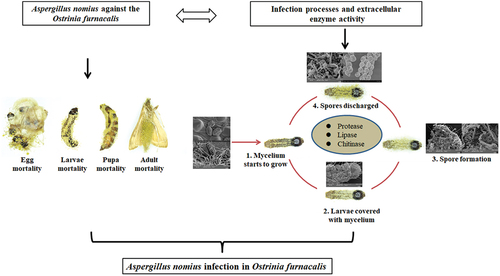Figures & data
Figure 1. Effect of O. furnacalis eggs on the hatching rate and the survival, mortality, and mycosis of the 1st instar larvae of O. furnacalis (n = 90) following spray infection with different A. nomius concentrations. (a) hatching rate of O. furnacalis eggs at 7 d post-infection (DPI) with A. nomius; (b and c) healthy eggs and mycosis of eggs; (d) survival probability of the 1st instar larvae of O. furnacalis; (e) mortality and mycosis of the 1st instar larvae of O. furnacalis infected withA. nomius; (f) A. nomiusmycosis of the 1st instar larvae of O. furnacalis; (g and h) log-probit regression line of concentration-mortality and mycosis of the 1st instar larvae of O. furnacalisto A. nomius.
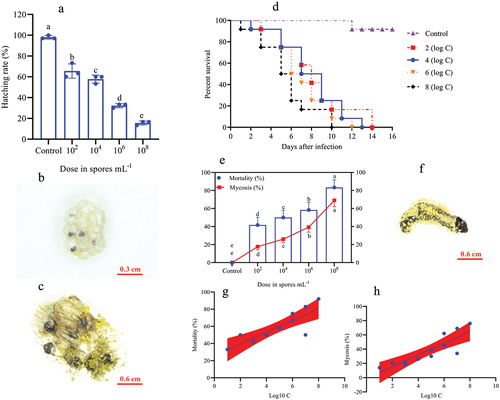
Figure 2. Survival, mortality, and mycosis of the 2nd and 3rd instar larvae of O. furnacalis (n = 90) following spray infection with different concentrations of A. nomius. (a and e) survival probability of the (a) 2nd and (e) 3rd instar larvae of O. furnacalis; (b and g) mortality and mycosis of the (b) 2nd and (g) 3rd instar larvae of O. furnacalis infected with A. nomius; (c and h) A. nomius mycosis on the (c) 2nd and (h) 3rd instar larvae of O. furnacalis; (d, e, i, and j) log-probit regression line of (d and i) concentration-mortality and (e and j) mycosis response of the 2nd and 3rd instar larvae of O. furnacalis to A. nomius.
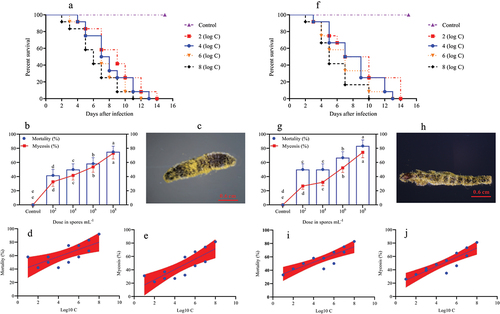
Figure 3. Survival, mortality, and mycosis of the 4th and 5th instar larvae of O. furnacalis (n = 90) following spray infection with different A. nomius concentrations. (a and f) survival probability of the (a) 4th and (f) 5th instar larvae of O. furnacalis; (b and g) mortality and mycosis of the (b) 4th and (g) 5th instar larvae of O. furnacalis infected with A. nomius; (c and h) A. nomius mycosis of the (c) 4th and (h) 5th instar larvae of O. furnacalis; (d, e, i, and j) log-probit regression line of (d and i) concentration-mortality and (e and j) mycosis response of 4th and 5th instar larvae of O. furnacalis to A. nomius.

Figure 4. Survival, mortality, and mycosis of pupae and adults of O. furnacalis (n = 90) following spray infection with different A. nomius concentrations. (a and f) survival probability of O. furnacalis (a) pupae and (f) adults; (b and g) mortality and mycosis of O. furnacalis (b) pupae and (g) adults infected with A. nomius; (c and h) mycosis of A. nomius on O. furnacalis (c) pupae and (h) adults; (d, e, i, and j) log-probit regression line of (d and i) concentration-mortality and (e and j) mycosis response of O. furnacalispupae and adult to A. nomius.
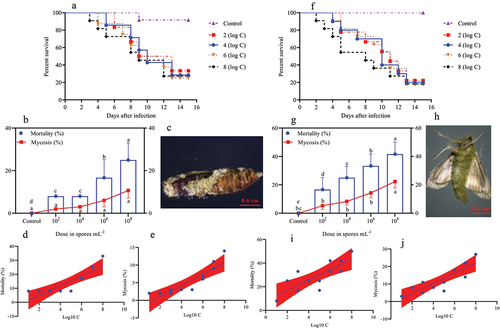
Figure 5. Effect of infection with A. nomius on the rate of pupa eclosion and pupa development of O. furnacalis.(a) pupa eclosion rate of O. furnacalis and malformed adults ofO. furnacalis emerged in a group of pupae infected with different A. nomius concentrations; (b) malformed O. furnacalis adults; (c) healthy O. furnacalis adults.
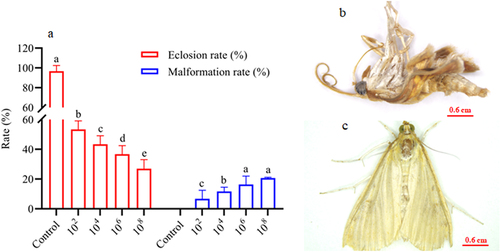
Table 1. LC50 values (conidia/mL) for A. nomius against different life-cycle stages of O. furnacalis..
Table 2. LT50 values (days) of A. nomius against different life-cycle stages of O. furnacalis..
Figure 6. Cuticle topography of the 3rd instar larvaeofO. furnacalis. (a) full view of a larva showing strumae and gentle surface topography; (b) gentle surface topography; (c) strumae surface topography; (d and e) sites beside the setae and proleg; (f) head capsule.
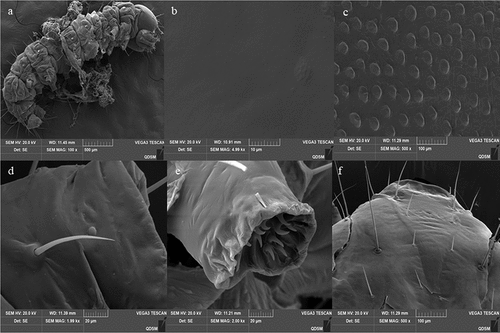
Figure 7. Conidial attachment and germination of A. nomius on the cuticle of the 3rd instar larvae of O. furnacalis observed under a scanning electron microscope. (a) conidium (Co) attached to the setal alveolus and the germination of a few conidia with formed germ tube (gt) within 8 h and appressorium (ap) at 24 h post-inoculation; seta = se. (b) appressorium (ap) and penetration pegs (pp) formed at 36 h post-inoculation. (c and d) numerous conidia germinated to form a germ tube (gt), conidial germination rates increased, and mycelium formed on the host surface within 36 h; penetration pegs = pp, hyphae = hy.
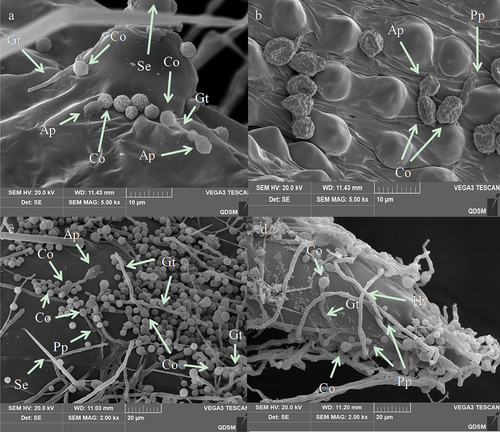
Figure 8. Penetration and conidia development and secondary conidiogenous structure of A. nomiuson the cuticle surface of the 3rd instar larvae ofO. furnacalis. (a) several hyphae penetrating the body wall from the setal alveolus outward from the body at 60 h; hyphae = hy. (b) hyphae of A. nomiusdeveloped, branched, and formed a dense mycelial mass on the cuticle 72 h after inoculation; hyphae = hy. (c and d) secondary conidiogenous structure formation of A. nomius84 h after inoculation; phialides = Ph, conidiophores = cp, vesicle = ve.
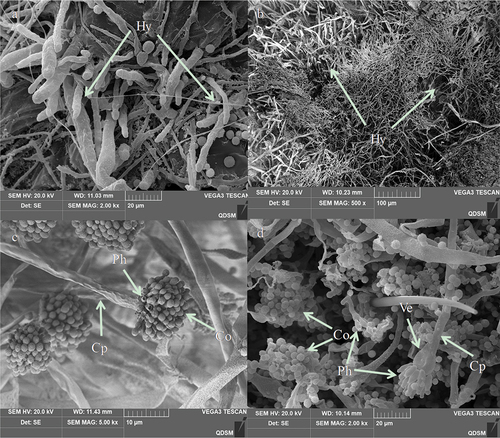
Figure 9. Scanning electron representative microscopy images of the 3rd instar larvae of O. furnacalis infected with A. nomius(120 h post-infection). (a) head capsule with abundant conidia and mycelial growth. (b) Extensive growth of mycelia in the abdomen. (c and d) full view of a larva showing complete mycelial networking.
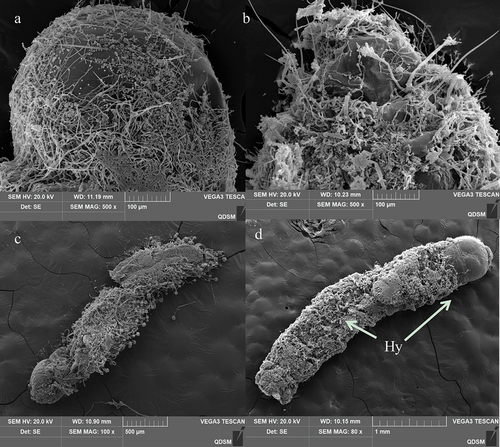
Figure 10. Activities of extracellular enzymes and their correlation with the virulence of A. nomius. (a) lipase activity, (b) protease activity, (c) chitinase activity, (d) relationship between the mortality rate of the 3rd instar larvae of O. furnacalis and lipase activity, (e) relationship between the mortality rate of the 3rd instar larvae of O. furnacalis and protease activity, (f) relationship between the mortality rate of 3rd instar larvae of O. furnacalis and chitinase activity.

Data Availability statement
The data used to support the findings of this study are available from the corresponding author upon request.

